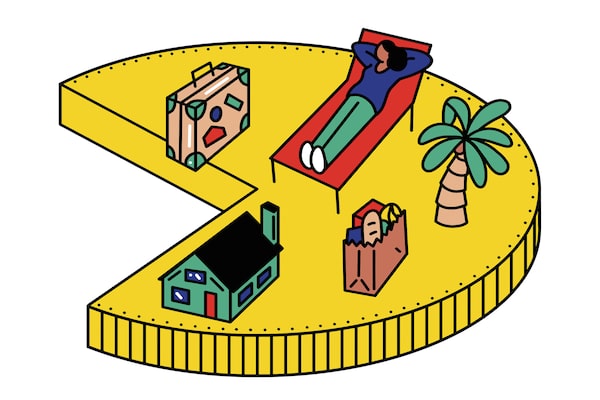
Illustration by Sam Island
Planning for your golden years doesn’t have to scare you. The reality of retirement is far more positive than people think. Ian McGugan answered commonly asked questions about planning for life after work. Here’s one to start.
What is the biggest misconception about retirement?
It’s the notion that you need to replace 70 per cent or 80 per cent of your working income in retirement. The financial industry has preached this notion for years, but it just doesn’t bear up under scrutiny.
“I’ve done the math umpteen times and I’ve concluded the correct figure is a lot closer to 50 per cent for most middle-class earners than 70 to 80 per cent,” says Frederick Vettese, an actuary and author of Retirement Income for Life. He says many middle-class couples spend most of their working lives making do on half or less of what they earn.
If a couple such as this replace 70 to 80 per cent of their working incomes in retirement, they will live better than they ever did while they working. That is not ideal if it means unnecessarily scrimping and saving during their prime working and child-rearing years.
The 3 biggest myths about retirement in Canada
To get a sense of how the numbers work, consider a 40-ish couple in Ontario. They each earn a healthy income – $80,000 a year. However, their paycheques take an immediate hit from taxes, Canada Pension Plan (CPP) contributions and Employment Insurance premiums. All told, those levies eat up about $40,000 of their combined $160,000 household income.
On top of that, this couple probably face mortgage payments. (Say, $20,000 a year.) Child-rearing costs, too. (Perhaps another $10,000 a year). If they also contribute $10,000 a year to a Registered Retirement Savings Plan, the amount they have left to spend on themselves is only $80,000 – half of what they started with.
In retirement, many of those expenses will be memories. The mortgage will probably be paid off. The children will be raised. The couple will no longer have to save for retirement because they are retired. And their tax bill will be considerably lower because their incomes are lower.
Most middle-class couples should be fine in retirement if they replace 50 to 60 per cent of their peak working incomes, says David Aston, author of The Sleep-Easy Retirement Guide. However, he stresses that people must consider the specifics of their own situation – individual circumstances matter a lot.
“There are situations where you might want to aim for a 70 per cent replacement ratio,” he says.
For instance, if you’ve never owned a home or had children, your expenses won’t dramatically drop in retirement. You will probably have to replace 60 to 70 per cent of your working income to maintain your standard of living, Mr. Aston says.
You may also want to plan for a higher income-replacement ratio if you earn a modest income – say, less than $50,000 a year. Since you’re not paying very much in taxes and since your spending is already tight, the amount of income you need in retirement will probably be quite close to what you were making while working.
The good news in this case is that government stipends – Old Age Security, CPP and the Guaranteed Income Supplement – do the heavy lifting needed to maintain the lifestyle of low-income earners, according to a 2016 study by the C.D. Howe Institute.
No matter what your income level, detail matters. Mr. Aston suggests you do a more personalized analysis of your situation as you get within a few years of retirement.
Figure out how much you are spending in key categories, from groceries and clothing to vacations and mortgage payments, then ask yourself how those expenditures will change in retirement. Try to estimate how much you will need every year to support the retirement lifestyle you want.
“This approach can reveal mindless, low-priority spending that you can easily cut,” Mr. Aston says. “And it also helps to avoid nasty surprises when you do retire.”

Ready to think about your (eventual) financial freedom?
Introducing Retire Rich Roadmap, a 5-part newsletter course to set you up with the tools you need to think about retirement, whether that's happening now or in a few decades. Sign up now – each lesson will land in your inbox on Thursday.